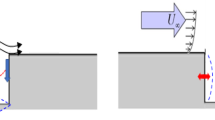This paper presents the results of the experimental investigation of the supersonic flow over a ring cavity of rectangular cross-section on a cylindrical body with a conical tip. The evolution of the flow over a cavity with its continuously changing extent has been investigated. The transition zone boundaries within which both an open and a closed schemes of flow are possible have been determined by the parameter of the relative extent of the cavity. It has been shown that the flow conditions in the transition zone depend on the prehistory of the flow. The main stages of cavity flow restricuting at the transition zone boundaries have been described.
Similar content being viewed by others
References
A. F. Charwat, J. N. Roos, F. C. Dewey, and J. A. Hitz, An investigation of separated flows. Part I: The pressure field, J. Aerosp. Sci., 28, No. 6, 457−470 (1961).
A. F. Charwat, C. F. Dewey, J. N. Roos, and J. A. Hitz, An investigation of separated flows. Part II: Flow in the cavity and heat transfer, J. Aerosp. Sci., 28, No. 7, 513−527 (1961).
R. L. Stalling and F. J. Wilcox, Experimental Cavity Pressure Distribution at Supersonic Speeds, NASA TP 2683 (1987).
J. Zhang, E. Morishita, T. Okunuki, and H. Itoh, Experimental investigation on the mechanism of flow-type changes in supersonic cavity flows, Trans. Jpn. Soc. Aeronaut. Space Sci., 45, No. 149, 170–179 (2002).
M. G. Morozov, Similarity of supersonic separation zones, Izv. Akad. Nauk SSSR, Mekh. Zhidk. Gaza, No. 6, 115−118 (1970).
V. I. Penzin, Separation flow in a ring groove, Uch. Zap. TsAGI, VII, No. 6, 124−130 (1976).
A. I. Shvets, Investigation of the flow in a cylindrical recess on an axisymmetric body in supersonic flow, Izv. Ross. Akad. Nauk, Mekh. Zhidk. Gaza, No. 1, 123–131 (2002).
S. V. Guvernyuk, A. F. Zubkov, M. M. Simonenko, and A. I. Shvets, Experimental investigation of the three-dimensional supersonic flow over an axisymmetric body with a ring cavity, Izv. Ross. Akad. Nauk, Mekh. Zhidk. Gaza, No. 4, 136–142 (2014).
S. V. Guvernyuk, A. F. Zubkov, and M. M. Simonenko, On the observation of the aerodynamic hysteresis in supersonic flow over a ring cavity on an axisymmetric body, in: Advances in the Mechanics of Continuous Media, Collected papers at the Int. Conf. timed to the 75th birthday of Academician V. A. Levin, OOO "Megaprint," Irkutsk (2014), pp. 163–168.
K. Mohri and R. Hillier, Computational and experimental study of supersonic flow over axisymmetric cavities, Shock Waves, 21, No. 3, 175−191 (2011).
A. D. Savel′ev, Numerical simulation of the supersonic flow over extended grooves, Uch. Zap. TsAGI, XLII, No. 3, 60−72 (2011).
S. J. Lawson and G. N. Barakos, Review of numerical simulations for high-speed, turbulent cavity flows, Prog. Aerosp. Sci., 47, No. 3, 186−216 (2011).
P. K. Chang, Separation of Flow, Pergamon Press, Oxford (1970).
F. Wilcox Jr., Tangential, semisubmerged, and internal store carriage and separation at supersonic speeds, AIAA Paper, 91-0198 (1991).
L. N. Cattafesta, D. R. Williams, C. W. Rowley, and F. S. Alvi, Review of active control of flow-induced cavity resonance, AIAA Paper, 2003-3567 (2003).
L. N. Cattafesta, Q. Song, D. R. Williams, C. W. Rowley, and F. S. Alvi, Active control of flow-induced cavity oscillations, Prog. Aerosp. Sci., 44, No. 7, 479−502 (2008).
N. Zhuang, F. S. Alvi, M. B. Alkislar, and C. Shih, Supersonic cavity flows and their control, AIAA J., 44, No. 9, 2118−2128 (2006).
J. Zhang, E. Morishita, T. Okunuki, and H. Itoh, Control of closed-type supersonic cavity flows, ICAS2002 CONGRESS, 393.1–393.8 (2002).
N. S. Vikramaditya and J. Kurian, Experimental study of influence of trailing wall geometry on cavity oscillations in supersonic flow, Exp. Therm. Fluid Sci., 54, 102−109 (2014).
X. Zhang and J. A. Edwardst, Experimental investigation of supersonic flow over two cavities in tandem, AIAA J., 30, No. 5, 1182−1190 (1992).
N. Taborda, D. Bray, and K. Knowle, Experimental investigation into transonic flows over tandem cavities, Aeronaut. J., 105, No. 1045, 119−124 (2001).
V. N. Zaikovskii, Ya. I. Smul′skii, and V. M. Trofimov, Influence of tandem cavities on the heat transfer in a supersonic flow, Teplofiz. Aéromekh., No. 3, 423−430 (2002).
T. Mathur, M. Gruber, K. Jackson, J. Donbar, W. Donaldson, T. Jackson, and F. Billig, Supersonic combustion experiments with a cavity-based fuel injector, J. Propuls. Power, 17, No. 6, 1305−1312 (2001).
T. Ukai, H. Zare-Behtash, E. Erdem, K. H. Lo, K. Kontis, and S. Obayashi, Effectiveness of jet location on mixing characteristics inside a cavity in supersonic flow, Exp. Therm. Fluid Sci., 52, 59−67 (2014).
R. C. Palharini and T. J. Scanlon, Aerothermodynamic comparison of two- and three-dimensional rarefied hypersonic cavity flows, J. Spacecraft Rockets, 51, No. 5, 1619−1630 (2014).
S. A. Isaev, Yu. M. Lipnitskii, A. N. Mikhalev, A. V. Panasenko, and A. E. Usachov, Simulation of the supersonic turbulent flow over a cylinder with coaxial disks, J. Eng. Phys. Thermophys., 84, Issue 4, 827–839 (2011).
M. R. Malik, Prediction and control of transition in supersonic and hypersonic boundary layers, AIAA J., 27, No. 11, 1487–1493 (1989).
V. Ya. Borovoi, Yu. Yu. Kolochinskii, and L. V. Yakovleva, Investigation of the influence of the unit Reynolds number on the boundary layer transition on a sharp cone, Izv. Akad. Nauk SSSR, Mekh. Zhidk. Gaza, No. 4, 32−38 (1982).
A. A. Maslov and S. G. Shevel′kov, Features of the laminar boundary layer transition on a cone, Izv. Akad. Nauk SSSR, Mekh. Zhidk. Gaza, No. 6, 23−27 (1985).
Author information
Authors and Affiliations
Corresponding author
Additional information
Translated from Inzhenerno-Fizicheskii Zhurnal, Vol. 89, No. 3, pp. 670–679, May–June, 2016.
Rights and permissions
About this article
Cite this article
Guvernyuk, S.V., Zubkov, A.F. & Simonenko, M.M. Experimental Investigation of the Supersonic Flow over an Axisymmetric Ring Cavity. J Eng Phys Thermophy 89, 678–687 (2016). https://doi.org/10.1007/s10891-016-1426-4
Received:
Published:
Issue Date:
DOI: https://doi.org/10.1007/s10891-016-1426-4




